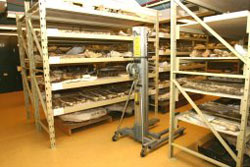Labeling
 The importance of having a catalog number on the specimen cannot be stressed enough. If a specimen becomes detached from its number, it has lost most of its scientific significance.
The importance of having a catalog number on the specimen cannot be stressed enough. If a specimen becomes detached from its number, it has lost most of its scientific significance.
The catalog number forms the link between the specimen, its associated data, and any direct derivatives such as molds, casts and photographs or other illustrations. Specimens, molds, casts and illustrations all should all be labeled with the relevant catalog number, to avoid breaking this link. For example, if a mold that lacks a catalog number cannot readily be linked to a specimen, the time taken by a preparator to make that mold has effectively been wasted.
The use of proper application methods and archival materials results in numbers and labels that remain legible, durable, and, if necessary, removable over time.
- Learn more about the recommended materials and tools
Resources
For additional information see the Labeling section in the associated PaleontologyPortal Collection Management module.
The recommendations on this page were drawn, in large part, from Assembling An Archival Marking Kit For Paleontological Specimens a poster presented at the 2006 Society of Vertebrate Paleontology Annual Meeting by Amy Davidson and Samantha Alderson of The American Museum of Natural History, New York, NY and Marilyn Fox of The Yale Peabody Museum of Natural History, New Haven, CT. The poster is available as a pdf document online.
Bibliography
Alten, Helen. "Numbering Museum Collections." ICOM Ethnographic Conservation Newsletter, Number 17, April 1998. pp. 18-21.
Braun, Thomas. J. An Alternative Technique for Applying Accession Numbers to Museum Artifacts. JAIC, 46 (2007): 91-104.
Koob, Stephen P. The Use of Paraloid B-72 as an adhesive: Its Application for Archaeological Ceramics and Other Materials. Studies in Conservation, Vol. 31, No. 1 (Feb. 1986), pp. 7-14.
Sullivan, B. and D.R. Cumberland, Jr. "Use of Acryloid B-72 Lacquer for Labeling Museum Objects" Conserve O Gram Number 1/4 (July 1993) National Park Service.
Williams, Stephen, and Catharine Hawks, "Inks for Documentation in Vertebrate Research Collections." Curator 29 (1986): 93-108.
Wood, Rose and Steve Williams. 1993. "An Evaluation of Disposable Pens for Permanent Museum Records." Curator 36/3.
Wood, Rose, "A Note on 'Inks.'" SPNHC Newsletter 2 (1988)
"Labeling and Marking Museum Objects" a fact sheet published by the MDA (Museum Documentation Association) of the UK.
The National Park Service’s Museum Handbook, Part II: Museum Records Web Edition has an Appendix J on marking collections. More specific information on marking paleontological collections is available in the Museum Handbook, Part I: Museum Collections Appendix U on the Care of Paleontological and Geological Collections.

